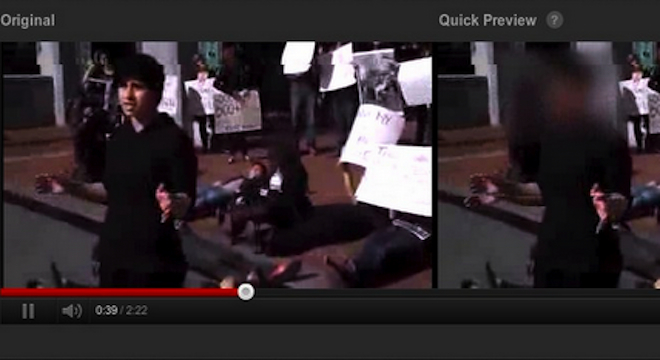Updated 3:10 p.m. ET, Wednesday, July 18
Many video subjects have become recognizable viral video sensations thanks to YouTube. But YouTube itself wants to allow some video subjets the ability to remain anonymous, too, if they choose: On Wednesday, the Google-owned online video hub launched a new “face blurring” video editing tool specifically for this purpose.
The tool allows video creators to upload their footage as before, but now they have the option, with the click of a button, to have YouTube’s software automatically detect and blur all of the human faces in their video files.
Called “Blur All Faces,” the tool is accessible by clicking on a user’s YouTube account name in the top right-hand corner of the website, then selecting “Video Manager,” then the “Edit” button to the right of the desired video, then “Enhancements,” then finally the “Additional Features” button.
YouTube began work on the feature on the fall of 2011. However, it is still being refined, as the company readily admits.
“This is emerging technology, which means it sometimes has difficulty detecting faces depending on the angle, lighting, obstructions and video quality,” wrote Amanda Conway, YouTube policy associate, in an official YouTube blog post announcing the feature.
“It’s possible that certain faces or frames will not be blurred. If you are not satisfied with the accuracy of the blurring as you see it in the preview, you may wish to keep your video private.”
YouTube spokesperson Jessica Mason further explained to TPM the technology’s limitations:
“Because it can be difficult to detect faces depending on the angle, lighting, and video quality, it’s possible that certain faces or frames will not get blurred. For example if a woman quickly puts a pair of sunglasses on her face the blurring tool continues to detect the face and blur it. However if that woman hold a big object in front of her face for a longer period of time, the technology might fail to detect the face.”
It’s also unclear whether the technology could be reverse-engineered or bypassed by a program that strips away the blurring.
“We can’t say it’s impossible to unblur, but we have made it incredibly difficult through pixelating the blurred regions and adding noise,” Mason told TPM. “In fact, we feel we’ve made it so difficult that it’s not worth the immense effort required to try.”
Specifically, the blurring option relies on facial recognition technology. An algorithm “scans a video and detects facial features like eyes,” then “blurs the detected faces by adding things like noise and pixelation to the detected features,” according to Mason.
YouTube’s Conway also points out that the footage could be equally useful for those wishing to upload “sensitive protest footage” as well as families looking to upload home movies without broadcasting their children’s faces to the Web.
But YouTube appears primarily concerned with how the footage could be an aid to human rights reporting, specifically videos documenting rights violations and atrocities around the globe. Conway’s post links to another set of YouTube suggestions for keeping video creators and subjects safe, including being aware of other details captured on video that “can give away identity like a license plate, a name tag, or even the background scenery.”
“Free expression is one of the greatest benefits and opportunities the Internet has to offer,” Mason added. “Our Face Blurring feature aims to help protect users who want to share an important message on YouTube, but do not want to share their identity. ”
The move was heralded as a major plus for human rights reporting by nonprofit advocacy group and YouTube partner WITNESS, which teamed-up with YouTube in May to launch the website’s official Human Rights Channel, which collects protest footage and footage of the work of activists around the globe.
“WITNESS has advocated for platforms to take this step for a number of years in blogs, public presentations, reports and private advocacy and applauds YouTube for leading the way in including this functionality,” wrote WITNESS program director Sam Gregory in a blog post.
The new “Blur All Faces” option could also have a direct impact on the worsening violence between government security forces and rebels in Syria, as Gregory noted.
“In places like Syria, activists on the ground note how often people are identified and tracked down because of the video that they share online,” Gregory wrote, highlighting the story of a video journalist reporting on the ground in Syria about how his friends were arrested and tortured by government investigators after being identified in video footage of a protest.
Gregory and WITNESS believe that there is a greater “need for visual anonymity options in a broader range of settings as visual media becomes a dominant form of communication and access to facial recognition increases.” He concludes his post by asking if other video and image-sharing websites will offer their users similar options to YouTube’s new tool.
WITNESS itself has been something of a pioneer in this effort, teaming up with the Guardian Project, a collection of personal security-minded developers, to release an open source Android app called ObscuraCam that also offers video face blurring tools for mobile phones.
No mobile device version of YouTube’s blur faces option is available yet, but it could be coming fairly soon. Mason said that YouTube would continue to add features, potentially even the ability to blur only selected faces or portions of a video.
Editor’s not: Updated throughout to add additional information provided by a YouTube spokesperson.






